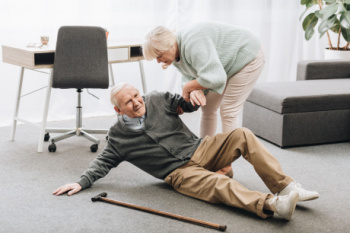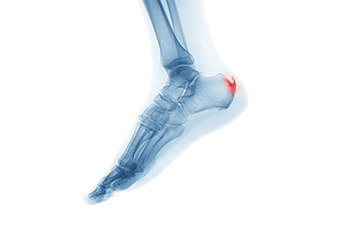Connect With Us
Blog
Items filtered by date: January 2025
How Foot Problems Can Increase the Risk of Falling in the Elderly

Foot problems are a significant concern for the elderly, as they can greatly increase the risk of falling. Common foot issues such as foot pain, swelling, redness, tingling, and numbness can affect a person’s ability to walk safely. Pain in the feet can lead to a person favoring one side, causing imbalance and instability. Swelling and redness may be signs of arthritis or infection, which can also impair movement. Tingling or numbness in the feet, often associated with conditions like diabetes or peripheral neuropathy, can reduce sensation and make it harder to feel the ground beneath. These symptoms may result in poor posture, difficulty walking, and an increased likelihood of tripping or falling. Regular foot care, wearing proper footwear, and seeking medical advice from a podiatrist for foot-related issues can help reduce these risks and improve overall mobility in the elderly. If you are a senior with one or more foot conditions, it is suggested that you are under the care of this type of doctor who can treat various foot ailments and provide fall prevention tips.
Preventing falls among the elderly is very important. If you are older and have fallen or fear that you are prone to falling, consult with Michael Schwartzman, DPM from Illinois and Indiana . Our doctor will assess your condition and provide you with quality advice and care.
Every 11 seconds, an elderly American is being treated in an emergency room for a fall related injury. Falls are the leading cause of head and hip injuries for those 65 and older. Due to decreases in strength, balance, senses, and lack of awareness, elderly persons are very susceptible to falling. Thankfully, there are a number of things older persons can do to prevent falls.
How to Prevent Falls
Some effective methods that older persons can do to prevent falls include:
- Enrolling in strength and balance exercise program to increase balance and strength
- Periodically having your sight and hearing checked
- Discuss any medications you have with a doctor to see if it increases the risk of falling
- Clearing the house of falling hazards and installing devices like grab bars and railings
- Utilizing a walker or cane
- Wearing shoes that provide good support and cushioning
- Talking to family members about falling and increasing awareness
Falling can be a traumatic and embarrassing experience for elderly persons; this can make them less willing to leave the house, and less willing to talk to someone about their fears of falling. Doing such things, however, will increase the likelihood of tripping or losing one’s balance. Knowing the causes of falling and how to prevent them is the best way to mitigate the risk of serious injury.
If you have any questions, please feel free to contact our offices located in West Chicago, IL and Whiting, IN . We offer the newest diagnostic and treatment technologies for all your foot care needs.
Heel Pain Can Be Treated!
Life After Ankle Fractures

An ankle fracture is a break in one or more of the bones forming the ankle joint, often caused by twisting injuries, falls, or direct trauma. While immediate pain, swelling, and difficulty walking are obvious challenges, the effects of an ankle fracture can ripple far beyond the injury itself. Recovery often demands immobilization, targeted exercises and stretching, and lifestyle adjustments, which can disrupt daily routines, work, and recreational activities. Prolonged periods of limited mobility can also impact mental well-being, making the injury feel even more overwhelming. If you have sustained an ankle fracture, it is suggested that you have ongoing appointments with a podiatrist who can help manage both the physical and long-term impacts of an ankle fracture.
Broken ankles need immediate treatment. If you are seeking treatment, contact Michael Schwartzman, DPM from Illinois and Indiana . Our doctor can provide the care you need to keep you pain-free and on your feet.
Broken Ankles
A broken ankle is experienced when a person fractures their tibia or fibula in the lower leg and ankle area. Both of these bones are attached at the bottom of the leg and combine to form what we know to be our ankle.
When a physician is referring to a break of the ankle, he or she is usually referring to a break in the area where the tibia and fibula are joined to create our ankle joint. Ankles are more prone to fractures because the ankle is an area that suffers a lot of pressure and stress. There are some obvious signs when a person experiences a fractured ankle, and the following symptoms may be present.
Symptoms of a Fractured Ankle
- Excessive pain when the area is touched or when any pressure is placed on the ankle
- Swelling around the area
- Bruising of the area
- Area appears to be deformed
If you suspect an ankle fracture, it is recommended to seek treatment as soon as possible. The sooner you have your podiatrist diagnose the fracture, the quicker you’ll be on the way towards recovery.
If you have any questions, please feel free to contact our offices located in West Chicago, IL and Whiting, IN . We offer the newest diagnostic and treatment technologies for all your foot care needs.
Understanding Bunions

A bunion is a bony bump that forms at the base of the big toe, causing it to angle inward toward the other toes. This condition can lead to pain, swelling, and redness surrounding the joint, making it difficult to find comfortable shoes. As the bunion develops, it can cause the toes to become misaligned, leading to additional discomfort and potential problems with walking. The primary cause of bunions is often hereditary, but wearing tight, narrow shoes, especially high heels, can make the condition worse. Foot deformities, such as flat feet, can also increase the risk. A podiatrist can help diagnose and manage bunions. Conservative treatments may include custom orthotics, padding, or recommending footwear changes to reduce pressure. In more severe cases, this type of doctor may suggest surgical options to realign the joint and alleviate pain. If you have developed a bunion, it is suggested that you schedule an appointment with a podiatrist.
If you are suffering from bunions, contact Michael Schwartzman, DPM of Illinois and Indiana . Our doctor can provide the care you need to keep you pain-free and on your feet.
What Is a Bunion?
A bunion is formed of swollen tissue or an enlargement of boney growth, usually located at the base joint of the toe that connects to the foot. The swelling occurs due to the bones in the big toe shifting inward, which impacts the other toes of the foot. This causes the area around the base of the big toe to become inflamed and painful.
Why Do Bunions Form?
Genetics – Susceptibility to bunions are often hereditary
Stress on the feet – Poorly fitted and uncomfortable footwear that places stress on feet, such as heels, can worsen existing bunions
How Are Bunions Diagnosed?
Doctors often perform two tests – blood tests and x-rays – when trying to diagnose bunions, especially in the early stages of development. Blood tests help determine if the foot pain is being caused by something else, such as arthritis, while x-rays provide a clear picture of your bone structure to your doctor.
How Are Bunions Treated?
- Refrain from wearing heels or similar shoes that cause discomfort
- Select wider shoes that can provide more comfort and reduce pain
- Anti-inflammatory and pain management drugs
- Orthotics or foot inserts
- Surgery
If you have any questions, please feel free to contact our offices located in West Chicago, IL and Whiting, IN . We offer the newest diagnostic and treatment technologies for all your foot care needs.
Heel Spurs and Their Causes

A plantar calcaneal spur, commonly known as a heel spur, is a bony growth that forms on the underside of the heel bone. A heel spur typically develops as a result of repetitive stress and strain on the foot, often linked to activities that involve high-impact movements like running or jumping. Prolonged standing, obesity, poor footwear, or abnormalities in foot structure such as flat feet or high arches can also lead to heel spurs. Over time, this pressure can cause the tissues on the bottom of the foot, particularly the plantar fascia, to pull away from the heel bone. This strain triggers bone formation as the body attempts to repair the area, leading to the growth of a spur. While the spur itself may not always cause pain, it can irritate surrounding tissues, resulting in discomfort or inflammation. If you have a heel spur, it is strongly suggested that you promptly contact a podiatrist.
Heel spurs can be incredibly painful and sometimes may make you unable to participate in physical activities. To get medical care for your heel spurs, contact Michael Schwartzman, DPM from Illinois and Indiana . Our doctor will do everything possible to treat your condition.
Heels Spurs
Heel spurs are formed by calcium deposits on the back of the foot where the heel is. This can also be caused by small fragments of bone breaking off one section of the foot, attaching onto the back of the foot. Heel spurs can also be bone growth on the back of the foot and may grow in the direction of the arch of the foot.
Older individuals usually suffer from heel spurs and pain sometimes intensifies with age. One of the main condition's spurs are related to is plantar fasciitis.
Pain
The pain associated with spurs is often because of weight placed on the feet. When someone is walking, their entire weight is concentrated on the feet. Bone spurs then have the tendency to affect other bones and tissues around the foot. As the pain continues, the feet will become tender and sensitive over time.
Treatments
There are many ways to treat heel spurs. If one is suffering from heel spurs in conjunction with pain, there are several methods for healing. Medication, surgery, and herbal care are some options.
If you have any questions feel free to contact our offices located in West Chicago, IL and Whiting, IN . We offer the latest in diagnostic and treatment technology to meet your needs.

